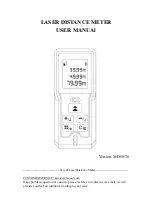
- 9 -
4.5.2 The calibration solution can be easily polluted, especially for low concentration solution
(0.19 mg/l). Please pay attention to avoid contamination otherwise a large measuring error will
occur. Replace the solution after 4~5 times of use.
4.5.3 When test solution in the order from low-concentration to high-concentration, the electrode
does not need to be rinsed, just shake off or dry the excess solutions with clean tissue. If it’s from
high-concentration to low-concentration, you need to rinse the electrode with distilled or deionized
water, otherwise it will affect the accuracy significantly.
4.5.4 Typically the meter needs to calibrated before use. But when requirement of accuracy is low,
calibration is not necessary. Or try the electrode in the calibration solution, if the error is very small,
calibration is not necessary.
4.5.5 According to the theory of Isothermal measurements of ion-selective electrode, the smaller
the difference of temperature between test solution and the calibration solution, the higher the
measument accuracy is. Typically, temperature difference between test solution and calibration
solution should ≤±15℃; for high accuracy measurement, the temperatures should be the same.
4.5.6
When test is completed, dry electrode and store with the cap on.
4.5.7 When the meter is functioning abnormally, please set P4 as
“
ON
”
to restore the meter to
factory default mode, and then perform calibration and measurements again.
5
pH Measurement
5.1
Preparing the Meter
5.1.1. Connect the 201T-S pH Electrode to the meter; loosen the cap of the storage bottle of
electrode; screw off the storage bottle; Press to turn on meter.
5.2
Meter Calibration
5.2.2. Use distilled water to rinse off electrode and then dry it with clean tissue, then soak it into
the pH7.00 buffer solution, stir the electrode gently and let it stand still,
5.2.1. Press to enter calibration mode, LCD displays C1, indicating the first point of
calibration; Wait for a stable reading and to appear and stay, then press again
,









































